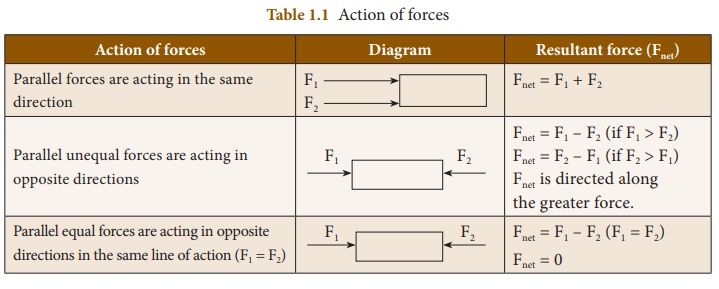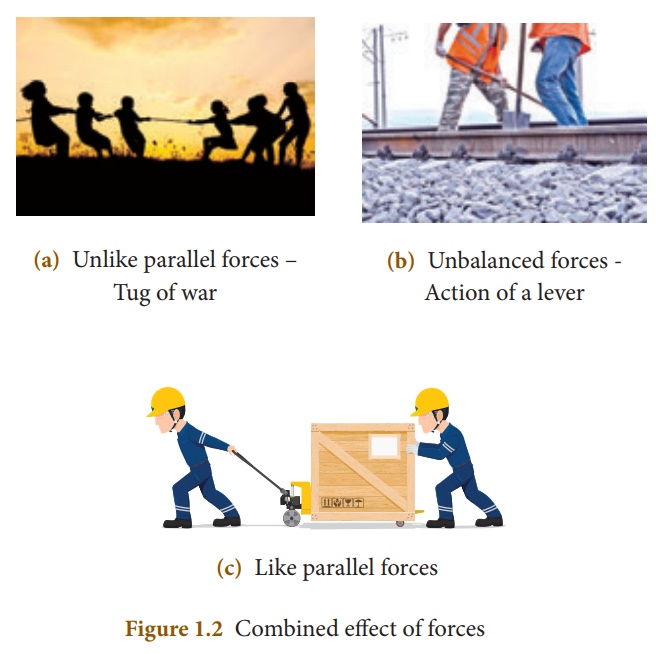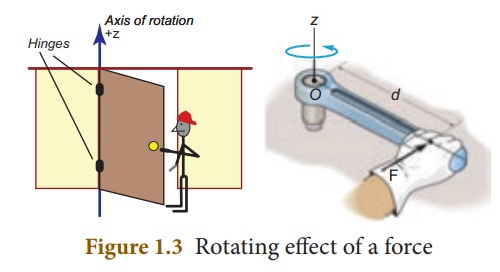Chapter: 10th Science : Chapter 1 : Laws of Motion
NewtonŌĆÖs Laws of Motion
NEWTONŌĆÖS LAWS OF MOTION
1. NewtonŌĆÖs First Law
This law states that
every body continues to be in its state of rest or the state of uniform motion
along a straight line unless it is acted upon by some external force. It gives
the definition of force as well as inertia.
2. Force
Force is an external
effort in the form of push or pull, which:
1. produces or tries to
produce the motion of a static body.
2. stops or tries to stop a moving body.
3. changes or tries to change the direction of motion of a moving
body.
Force has both magnitude
and direction.
So, it is a vector
quantity.
3. Types of forces
Based on the direction
in which the forces act, they can be classified into two types as:
(a) Like parallel forces
and (b) Unlike parallel forces.
a) Like parallel forces:
Two or more forces of
equal or unequal magnitude acting along the same direction, parallel to
each other are called like parallel forces.
b) Unlike parallel
forces: If
two or more equal forces or unequal forces act along opposite directions
parallel to each other, then they are called unlike parallel forces. Action of
forces are given in Table 1.1.
4. Resultant Force
When several forces act
simultaneously on the same body, then the combined effect of the multiple forces
can be represented by a single force, which is termed as ŌĆśresultant forceŌĆÖ.
It is equal to the vector sum (adding the magnitude of the forces with their
direction) of all the forces.


If the resultant force
of all the forces acting on a body is equal to zero, then the body will be in
equilibrium. Such forces are called balanced forces. If the resultant
force is not equal to zero, then it causes the motion of the body due to
unbalanced forces
Examples: Drawing water from a
well, force applied with a crow bar, forces on a weight balance, etc.
A system can be brought
to equilibrium by applying another force, which is equal to the resultant force
in magnitude, but opposite in direction. Such force is called as ŌĆśEquilibrantŌĆÖ.
5. Rotating Effect of Force
Have you observed the
position of the handle in a door? It is always placed at the edge of door and
not at some other place. Why? Have you tried to push a door by placing your
hand closer to the hinges or the fixed edge? What do you observe?
The door can be easily
opened or closed when you apply the force at a point far away from the fixed
edge. In this case, the effect of the force you apply is to turn the door about
the fixed edge. This turning effect of the applied force is more when the
distance between the fixed edge and the point of application of force is more.

The axis of the fixed
edge about which the door is rotated is called as the ŌĆśaxis of rotationŌĆÖ.
Fix one end of a rod to the floor/wall, and apply a force at the other
end tangentially.
The rod will be turned
about the fixed point is called as ŌĆśpoint of rotationŌĆÖ.
6. Moment of the Force
The rotating or turning
effect of a force about a fixed point or fixed axis is called moment of the
force about that point or torque (Žä). It is measured by the product
of the force (F) and the perpendicular distance (d) between the fixed point
or the fixed axis and the line of action of the force. Žä = F ├Ś d . . . . . (1.2)
Torque is a vector
quantity. It is acting along the direction, perpendicular to the plane
containing the line of action of force and the distance. Its SI unit is N m.
Couple: Two equal and unlike
parallel forces applied simultaneously at two distinct points constitute
a couple. The line of action of the two forces does not coincide. It does not
produce any translatory motion since the resultant is zero. But, a couple
results in causes the rotation of the body. Rotating effect of a couple is
known as moment of a couple.
Examples: Turning a tap, winding
or unwinding a screw, spinning of a top, etc.
Moment of a couple is
measured by the product of any one of the forces and the perpendicular distance
between the line of action of two forces. The turning effect of a couple is
measured by the magnitude of its moment.
Moment of a couple =
Force ├Ś perpendicular distance between th line of action of forces
M = F ├Ś S. . . . . . . . . . . . . (1.3)
The unit of moment of a
couple is newton metre (N m) in SI system and dyne cm in CGS system.
By convention, the direction
of moment of a force or couple is taken as positive if the body is rotated in
the anti-clockwise direction and negative if it is rotate in the clockwise
direction.![]()
![]()
They are shown in
Figures 1.4 (a and b)

7. Application of Torque
1. Gears:
A gear is a circular
wheel with teeth around its rim. It helps to change the speed of rotation of a
wheel by changing the torque and helps to transmit power.
2. Seasaw
Most of you have played
on the seasaw. Since there is a difference in the weight of the persons sitting
on it, the heavier person lifts the lighter person. When the heavier person
comes closer to the pivot point (fulcrum) the distance of the line of action of
the force decreases. It causes less amount of torque to act on it. This enables
the lighter person to lift the heavier person.
3. Steering Wheel
A small steering wheel
enables you to manoeuore a car easily by transferring a torque to the wheels
with less effort.
8. Principle of Moments
When a number of like or
unlike parallel forces act on a rigid body and the body is in equilibrium, then
the algebraic sum of the moments in the clockwise direction is equal to the
algebraic sum of the moments in the anticlockwise direction. In other words, at
equilibrium, the algebraic sum of the moments of all the individual forces
about any point is equal to zero.

In the illustration
given in figure 1.5, the force F1 produces an anticlockwise rotation
at a distance d1 from the point of pivot P (called fulcrum) and the
force F2 produces a clockwise rotation at a distance d2
from the point of pivot P. The principle of moments can be written as follows:
Moment in clockwise
direction = Moment in anticlockwise direction
F1 ├Ś d1 = F2 ├Ś d2 . . . . . . . . . (1.4)
Related Topics